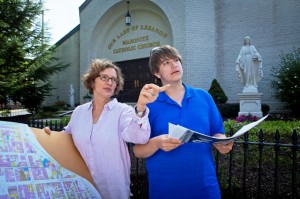Like the best discoveries, this one happened by chance.
While conducting other research, Andrea Smith became curious about an old Easton community known locally as “Syrian Town.” Seven years later, her look into Easton’s past continues to gain momentum.

Professor Andrea Smith and Walter Burkat ’16 in the Easton community that used to be known locally as “Syrian Town”
Demolished as part of the city’s urban renewal project in the 1960s, the neighborhood was home to people of Lebanese, Italian, African American, German, and Irish descent. Since 2007, Smith, associate professor of anthropology and sociology, has been working with student research assistants to interview elderly former residents and record their recollections. This spring, Smith offered a community-based research course, Rebuilding Shattered Worlds through Recollection, based on the project.
Smith and her students are interested in why residents—most of them in their 70s, 80s, and 90s—love to gather and talk about their former home.
“It was rare in the 1940s-60s to see people of different ethnicities and racial backgrounds living intermixed on the same blocks, frequenting each other’s businesses, etc.,” says Smith. “While the increased racial segregation has been studied a great deal in other cities such as Chicago or Detroit, the fate of integrated neighborhoods is rarely a focus. My students and I have been interested in how this integration influences contemporary behaviors, such as speech, and may explain why people who lived there miss it so much.”
After learning about research ethics and ethnographic/oral history interview methods, students conducted interviews, transcribed their tapes, and sent them back for corrections. When the residents expressed interest in having a volume recording their recollections, students prepared draft chapters that Smith hopes to publish this fall. Thanks to a Lafayette award, she can distribute the volume to community participants for free.
Walter Burkat ’16 (Belvidere, N.J.), a double major in French and anthropology & sociology, began working on the project for Rebuilding Shattered Worlds and continued through the EXCEL Scholars undergraduate research program. (The earlier stages of the project led to several publications with EXCEL Scholars.) This summer, he gathered supplemental research, wrote a section for the volume on Lebanon’s relationship to France and how it influences people’s memory of the home country, and assisted with revising and editing the work.
Smith and Burkat are now working with Eric Luhrs, director of digital scholarship services, and John Clark, data visualization and GIS librarian, to create a website that will be a “virtual neighborhood” through a portion of the $700,000 grant the College received from The Andrew W. Mellon Foundation to explore digital humanities.
The team is reconstructing the neighborhood with images from old First Insurance Company maps, using this as a template for storing images of former shops, houses, and street scenes. They also will add audio files from some of the recorded interviews.

2 Comments
As both a former Easton resident and Lafayette graduate, your research into Syrian Town is of great interest to me. As a student at Wolf Jr. High School, which I believe is no longer in existence, I made many good friends from that community and I have often wondered what has happened to many of them. After graduation from Lafayette I did graduate work in Cleveland and then relocated to Baltimore and New York City. My contacts with Easton became fewer and fewer (except for Lafayette) and the forthcoming history I’m interested in reading. I’m retired in Fort Myers, Florida and would certainly be willing to purchase a copy of the book, no matter the cost.
Copies of any written materials developed from this project would be a welcome addition to the collection at the Jane Moyer Library at the Sigal Museum of the Northampton County Historical and Genealogical Society.
Comments are closed.